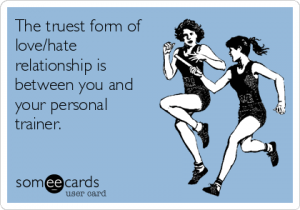 If you’re reluctant about working out when you’re sore, you may have reason to worry. Then again, you may actually need to workout and get through the discomfort. The immediate thought is to take a rest, but the key to whether workout or not is just how sore you are. If it’s extremely painful to move, not only do you need to set aside your workout, you need to seek medical attention. Unbearable pain is not part of the program and may indicate a serious injury that needs care.
If you’re reluctant about working out when you’re sore, you may have reason to worry. Then again, you may actually need to workout and get through the discomfort. The immediate thought is to take a rest, but the key to whether workout or not is just how sore you are. If it’s extremely painful to move, not only do you need to set aside your workout, you need to seek medical attention. Unbearable pain is not part of the program and may indicate a serious injury that needs care.
Watch for signs of injury.
There’s a huge difference between pain and soreness. Soreness indicates discomfort and that usually decreases in two to three days. Injury requires medical attention and includes symptoms like sharp pain, swelling, constant pain with no relief, numbness, black and blue marks and tingling or numbness. It can also bring a feeling of nausea when exerting effort on the injured area. Use ice and home medication for these symptoms and don’t go back to exercise for a day or two. If the symptoms are serious, get medical treatment.
Why you may be feeling pain if there’s no major injury.
Every time you workout hard, it causes the muscle tissue to break down a little, especially if you’re working on new exercises or boosting the intensity of old ones. Those micro tears in the muscles can remind you that you worked out the day previously. It’s also how you build muscle tissue. The body responds and repairs the tears, making them even stronger against future damage.
Don’t do the same routine the next day, but use different exercises.
You won’t be doing yourself a favor by doing the same routine each day. That doesn’t give your muscle tissue time to heal. Instead, alternate your workout. If you’re sore, try stretching exercises or go for a walk. It actually can help with recovery. Active recovery, doing light strength training, stretching and low intensity cardio, like swimming, boosts circulation and can be as good as getting a massage!
- When you’re working out, make sure you not only rest your muscles after a tough workout and work a different group, but also that you get enough protein to help rebuild any tears in the muscle tissue.
- Delayed onset muscle soreness—DOMS—can be averted by doing workouts with resistance bands or getting a massage. Always make sure you have a warm up and cool down routine.
- Overtraining can be dangerous and set you back. If you’re working out too much or too hard every day, it can increase the resting heart rate, change your mood, lower your resistance, cause fatigue and insomnia, lower your performance and cause overuse injuries.
- Vary your workout and don’t work on the same muscle groups every day.
